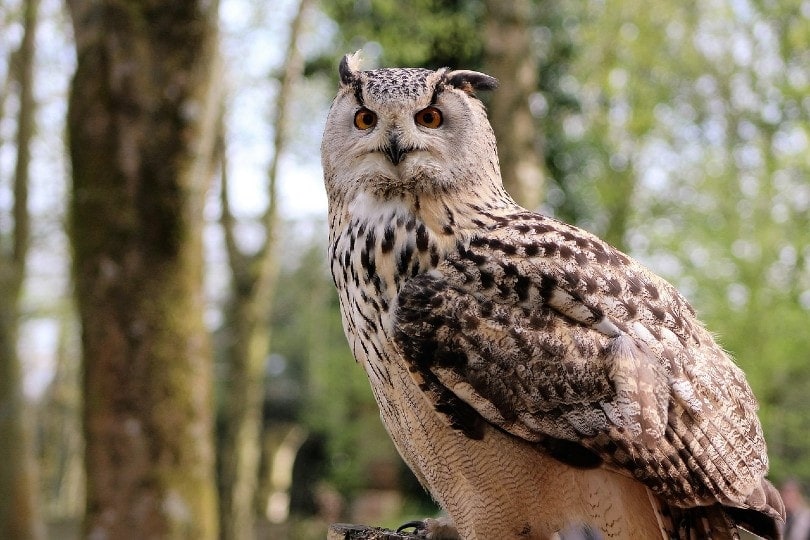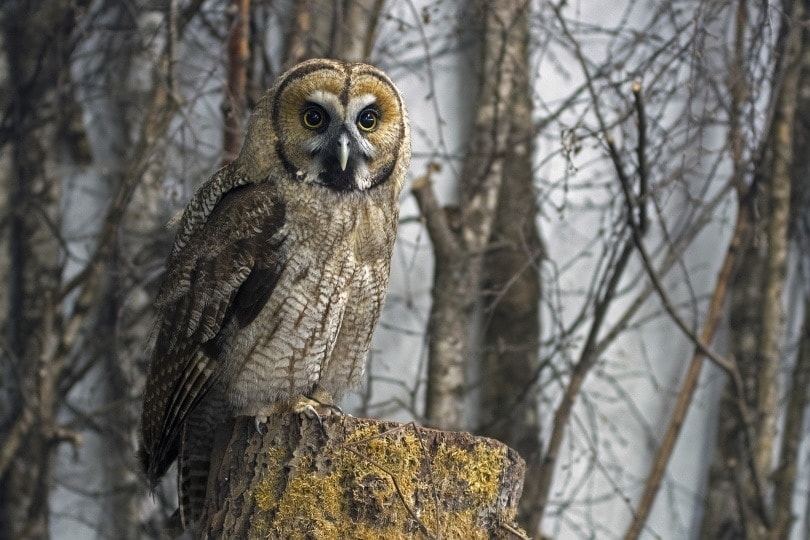How Intelligent Are Owls? Here’s What Science Says
Last Updated on

Owls differ from other birds in their anatomy, behavior, and social structure. They break all the rules about what we think of with these animals. The intelligence of parrots is well-documented, thanks to the long history of bird cognition research. The challenges for the two groups exist on opposite ends of the spectrum.
Owls have forward-facing eyes compared to the lateral ones of most other birds. They are nocturnal versus the diurnal or daytime activity of other species. Whereas many birds gather in flocks, owls generally mate for life and don’t roost with others of their kind for the most part. Like hawks, they are predators, which plays a vital role in their behavior. Does it mean that owls are intelligent?

Defining Intelligence

Applying a human idea of intelligence to animals isn’t the best way to approach this question. People are good at being people and owls as owls. Instead, we must look at the skills that show a higher level of thought processing. We can narrow it down to three measures:
- Social intelligence
- The ability to solve problems
- The ability to draw conclusions from experience to concept
Social intelligence helps animals cooperate in groups. It comes into play with mobbing when crows squawk and carry on when they spot a hawk flying overhead or roosting in a tree. Research suggests that it’s not as critical for socialization as it is for developing cognition or brainpower. Owls are limited in their actions with others. However, they can form some associations.
Problem-solving can involve a broad range of skills, from tool use to food storage. It’s well-documented with other bird species, such as crows, ravens, and cockatoos. Scientists have found that owls can relearn skills later in life. However, adults don’t have this ability. Nevertheless, these birds have some functional abilities, such as caching their prey which suggests some intelligence and concept of time.
Owls have a limited number of vocalizations when you compare them to an African Grey or even a Budgerigar. Communication is vital for social birds. However, it’s not unusual when you think about it. They don’t need to attract a mate with a song. They rely on stealth instead of calls to hunt. Owls are most active at night, where silence is a competitive edge.
The last item on our list involves an animal’s ability to make the association between stimuli and events. Think of Pavlov’s dogs and their reaction to the sound of the bell. Experience is an excellent teacher. Social birds learn from each other by observing the behavior of others. Owls don’t have the same opportunities for picking up new skills.
We can conclude from these points is that an owl’s intelligence is limited by what the species needs to survive. However, let’s delve some more into what that involves in the bird’s natural history.
Owl Anatomy

The research on parrot cognition has focused on the bird’s brain anatomy. Evidence suggests that these animals developed larger brains with modifications in the structure on a similar but different path than humans. Owls evolved in ways that optimize their response to environmental stimuli. It makes sense when putting it context with the owl’s anatomy.
As we mentioned earlier, owls have forward-facing eyes like other predators, such as humans. They even see as we do. Their eyes are large, which is a good thing if you hunt at night as they do. Owls can see distant objects like rodents better than things close to them. The structure of this organ boosts their depth perception, too. All these adaptations make them superior hunters.
Owls can swoop down on their prey silently, thanks to the serrated edges of their wings. They also fly lower than most raptors. Their sense of hearing is keen, with asymmetrical ears. Owls can hone in on their prey with amazing precision to complement their silent flight. These things speak to their hunting ability but not necessarily to their intelligence.
We’re left with an animal that is highly adapted as a predator, with several specialized adaptations that help ensure its success. Many are unique to these species. We can safely say that the owl is at the top of its game. The takeaway is that evolution has equipped these birds physically for survival and less on intelligence since it’s the more adaptive solution for survival.
Owl Behavior

Owls have territories. Vocalizations are an integral part of maintaining these boundaries. Interestingly, males and females have different calls. They have their set nesting and roosting spots. These birds have no hesitation about defending it, either. Scent marking isn’t necessary for animals that don’t smell. Taste isn’t vital for an animal that swallows its food whole.
These nocturnal hunters often use abandoned nests for their own once the breeding season starts. That suggests some intelligence to find these spots for their use.

Conclusion
Many people put owls at the head of the class when it comes to intelligence. After all, isn’t that why we call them wise? The truth is that this association exists more because of mythology than fact. Owls have the adaptations they need to earn their place on the top of the food chain. Their outstanding eyesight and hearing make them excellent hunters. Even so, owls aren’t the most intelligent of birds.
Featured Image Credit: Kevinsphotos, Pixabay
Table of Contents
About the Author Robert Sparks
Robert’s obsession with all things optical started early in life, when his optician father would bring home prototypes for Robert to play with. Nowadays, Robert is dedicated to helping others find the right optics for their needs. His hobbies include astronomy, astrophysics, and model building. Originally from Newark, NJ, he resides in Santa Fe, New Mexico, where the nighttime skies are filled with glittering stars.
Related Articles:
How to Clean a Refractor Telescope: Step-by-Step Guide
How to Clean a Telescope Eyepiece: Step-by-Step Guide
How to Clean a Rifle Scope: 8 Expert Tips
Monocular vs Telescope: Differences Explained (With Pictures)
What Is a Monocular Used For? 8 Common Functions
How to Clean a Telescope Mirror: 8 Expert Tips
Brightfield vs Phase Contrast Microscopy: The Differences Explained
SkyCamHD Drone Review: Pros, Cons, FAQ, & Verdict
